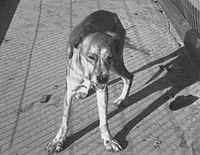
Photo from wikipedia
This study aims to evaluate the effect of the presence of food and the material used in a panel of biomarkers in saliva of horses. For the food effect study,… Click to show full abstract
This study aims to evaluate the effect of the presence of food and the material used in a panel of biomarkers in saliva of horses. For the food effect study, clean saliva was incubated with a known amount of food consisting of oats, hay or grass. Significant changes were observed when saliva was incubated with oats for total protein (P = .050) and phosphorus (P = .008), with grass for total protein (P = .037), salivary alpha-amylase (sAA, P = .018), total esterase (TEA, P = .018), butyrilcholinesterase (BChE, P = .037), adenosine deaminase (ADA, P = .037), and total bilirubin (P = .018), and with hay for sAA (P = .018), phosphorus (P = .037), γ-glutamyl transferase (gGT, P = .004), and creatine kinase (CK, P = .016). For the material-based collection study, saliva using a sponge and a cotton role at the same time were collected and compared. Lower values were obtained in clean saliva collected with cotton role compared to sponge for sAA (P = .030), TEA (P = .034), BChE (P = .003), gGT (P = .002) and cortisol (P < .001) In conclusion, the presence of food and the material used for its collection, can influence the results obtained when analytes are measured in saliva of horses.
Journal Title: Research in veterinary science
Year Published: 2020
Link to full text (if available)
Share on Social Media: Sign Up to like & get
recommendations!